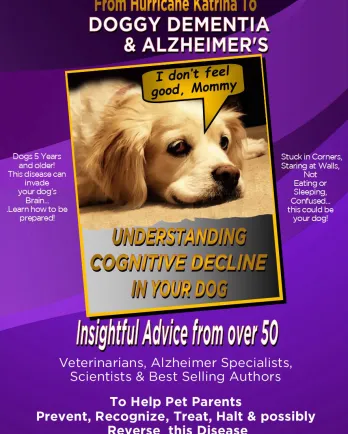Shamrock’s Story: What my dog taught me about the signs of Canine Cognitive Dysfunction
Editor’s Note: This is a guest post on the Grey Matters Blog and not written by anyone affiliated with Grey Muzzle. We allow guest contributors from time to time in order to provide our supporters with a wide range of topics pertaining to senior dogs.
Can your dog get dementia?
When I asked groups of pet parents, the majority answered, “definitely not!” They adamantly suggested this disease is a human complication of old age. Even after having had nine dogs in my lifetime, I was one of those people.
But then my Shamrock, a springer/cocker spaniel-mix taught me differently. Shamrock and Clover were littermates, rescued during Hurricane Katrina. I fostered them and finally when their family was not located 18 months later, was able to officially adopt them both. Ten years later, Clover succumbed to liver cancer. From that moment on I watched Shamrock for any signs of the same cancer and had her tested regularly. Thankfully, everything was fine.
However, about three years later at age 13, she started exhibiting strange behavior: she stopped wagging her tail; didn’t bark when a stranger came on the property; and no longer sat looking out the front window at her favorite spot.
Her veterinarian could find no physical cause and chocked it up to loneliness and possible depression caused by the loss of her sister. He suggested keeping an eye on her and letting him know if anything else occurred. Little did any of us know that Shamrock was telling us, actually warning us, of impending issues. These were the early signs of her cognitive decline.
The next issues I noticed were physical ones. Because Shamrock was a springer spaniel, jumping was second nature. But suddenly, she wasn’t jumping as high, or as well. I installed ramps to help her onto furniture and into her outside bathroom area, but she was very hesitant to use them. Then Shamrock started having some limping issues. The x-rays and exams only showed some mild arthritis; nothing that would really explain the situation. We were referred to orthopedic veterinarians at Virginia Tech, and their conclusions were the same. Their suggestions were daily massage and weekly manipulation therapy. These practices helped, so I added daily “doga” and stretching routines. These finally got her back on her paws without limping, but she never really jumped again.
By age 15, Shamrock started exhibiting more extensive behavioral changes. She had no interest in being held, kissed, or comforted. She started to pace aimlessly, often for hours, and then she would sleep intermittently. When she was awake, Shamrock wanted to go out constantly. However, when she got outside, she would stand still as if she had no idea why she was there, but she would be adamant about not wanting to go back inside.
Another visit to her veterinarian again showed no changes, and all her blood work was normal. This time the referral was to Neurology. Their findings showed no specific conclusions on exam but suggested an MRI would at least rule out a tumor. I was concerned about the complications of anesthesia and asked for other suggestions.
In lieu of a tumor, which they didn’t really believe she had, “Canine Cognitive Dysfunction; doggy dementia, or CCD for short” was their answer. The neurologist explained that CCD is similar to dementia and Alzheimer’s in humans, and dogs develop signs because they are exposed to our environment, and our practices. Therefore, “the diseases that affect us, can also affect our dogs.”
I just shook my head. Then she handed me a written explanation of her conclusions. I only glanced at the paper which listed contributing factors to CCD:
- Environment: Dogs live in our environment, and they can be exposed to toxins, chemicals, pesticides, etc.
- Diet: Dogs may be eating a poor diet, heavily laden with preservatives, grain based with high complex carbohydrates and poor sources of protein. Many dogs become overweight and lack proper exercise
- Dogs may also lack brain stimulation, and many other contributing factors that cause plaque formation in the brain, a major cause of Canine Cognitive issues.
I didn’t even finish reading the material and my mouth fell open in disbelief. I’ve had dogs all my life; many that lived into their twenties, and years ago I had worked for a pet food company, so I was very aware of these issues. It seemed the neurologist’s answer was the same as when my medical doctor can’t find a cause for my symptoms and says, “it must be some syndrome.” I felt like shouting, “Dogs don’t get dementia!”
The neurologist suggested I speak with our veterinarian and discuss her conclusions. She asked me to consider Shamrock’s diet and routines and also to think about adding supplements like omega 3, exploring brain games, sniff walks, and other calming aids. She handed me a prescription and said, “If these changes don’t slow the progression, consider adding this prescription for Shamrock, to control her anxiety.”
I left in tears for my “baby.” Outside the facility, I walked with Shamrock, gave her water, treats and hugs, and calmed down for the ride home. I refused to let this get to me. Shamrock was still healthy, and no one had diagnosed anything fatal. I knew my job as her pet parent was to do whatever I could to help her.
When I got home, I read all the information the neurologist provided and began to research CCD. I also journaled all her signs. Finally, I had no choice but to accept that she was showing signs of dementia and that I was wrong.
Dogs Do Get Dementia!
I made an appointment with her veterinarian. He started Shamrock on some supplements and calming aids, but these few small changes weren’t doing enough. She would stare into space, then become very restless. Other times she would get stuck in corners and not know how to back out. Her sleep became more erratic, and she showed a lot of confusion.
Thinking back, I realize now that the very early signs—the changes in her behavior she exhibited at 13-years-old—were key to recognizing her condition, but my lack of knowledge and understanding of this disease caused a hunt and peck delay of almost two years.
So how do you know if your dog is a candidate for cognitive issues or already has signs of CCD?
The best answer, according to the over 50 veterinarians, Alzheimer’s experts, behaviorists, researchers, and best-selling authors I interviewed in this field was, “Dogs, age five and up can be candidates. This is not just a disease of old age, or breed or size, this is a disease of many factors.”
Whether for a young or a senior dog, it is essential to understand that early detection and treatment may help. Pet parents can begin to learn about and implement preventative techniques long before signs appear. They should also familiarize themselves with the behavioral signs that can manifest in their dog and to alert their veterinarian and act quickly to battle cognitive decline. Sadly, no one can prevent CCD in dogs, just as we cannot prevent Alzheimer’s in people. Another important point to be aware of is when a dog exhibits one sign, usually more will come.
Diagnosis of CCD is a process of elimination, ruling out other diseases first. When all blood work and physical exams are normal, the veterinarian may look for cognitive issues. But veterinarians only see our dogs on a sporadic basis, so the pet parent needs to be aware of what to watch for and relay those signs ASAP.
Unfortunately, most pet parents only take note when their dog is going to the bathroom in the house. Other signs they should question are excessive barking, not sleeping or eating, getting stuck in corners, or getting lost in their own house.
But there are many other signs that pet parents need to watch for.
Understanding the signs:
So, how do you know if a sign is something to be concerned about? Every dog is different, and their signs may not be classic, so you should discuss any behavioral changes with your veterinarian. Slow and silent should signal loud alarm bells! This disease has a normally slow progression rate with subtle changes that are not only hard to recognize, but easily confused with other issues. That is why pet parents don’t really notice these changes at first. In Shamrock’s situation her first signs seemed to be more emotional, but looking back, I can now add that she wasn’t as affectionate, didn’t want to sit with me, or be petted for more than a few minutes. She also stopped licking faces.
Now I understand these were early indicators. Doctors believed these changes were because she missed her sister. While that may have been a part of the reason, it certainly was not the sole cause.
The next stage in the progression of this disease can range from anxiety to aggression, depression, coordination issues and more. From that point on the list of signs may become significantly more extensive including: incontinence, forgetfulness of housetraining habits, confusion or disorientation, changes in sleep habits, little or no interest in social interaction, decreased activity, difficulty recognizing people and places, staring—sometimes for extended periods of time, unresponsiveness when called and attention deficit.
Unfortunately, as time goes by, signs can increase in intensity and may include wandering around aimlessly, pacing, circling endlessly (often in a tight left to right pattern, becoming tighter and tighter with an inability to stop even when distracted) and “sundowners.” Sundowners can create a day and night confusion, time turned upside down. (Some dogs do sleep at night, but even with medication, it can be for a very short periods of time, or constantly disturbed in a sleep/wake cycle). During those waking hours they may walk, pace, get stuck in corners, and circle endlessly. Some dogs will sleep intermittently during the day, usually from exhaustion, sometimes collapsing into sleep or even passing out from lack of sleep. If your dog experiences sundowners or other signs of dementia, barking may be an expression of confusion and anxiety. Additional symptoms include loss of appetite, not wanting to eat their regular diet, and/or total refusal to eat and weight loss.
Awareness of signs and interventions
The key to battling this disease is acceptance that dogs do get dementia and intervention at the earliest signs of behavioral changes; and to discuss symptoms and changes with your veterinarian. This step can help to begin any needed treatments ASAP. After treatments begin, watch for any changes, and stay ahead of any further problems. Sometimes treatments or medications will need to be tweaked. Therefore, it is extremely important to stay in contact with your veterinarian and advise any changes or new signs you notice. This step will also help to rule out any other causes and implement new treatments if needed to help slow any further progression.
Because this is a shared disease for both humans and dogs, this field of study is being explored every day and there is more and more information available related to Canine Cognitive Dysfunction. During the two years, I spent interviewing experts for "Shamrock’s Story,” the information needed to be constantly updated. Even after publication of this book, a “What’s New” web page was added to post news about both the human and canine perspectives of this disease. Alzheimer’s experts, and groups like “The Dog Aging Project" (who just published a study that proved that 52% of dogs from age 10 up will develop signs of dementia) researchers and organizations devoted to learning about dogs and this disease are giving us new awareness. In my opinion, the best practice every day is still, “early recognition of signs are key” …At least until there is a cure!
About the Contributor:
F. Barish-Stern is the author of books, award-winning stories, and articles. Over the years she has taught writing and used her editing skills to help other writers develop and publish their books. Barish-Stern writes sci-fi fantasy (“Code 47 to BREV Force—the Trilogy”), non-fiction (“How to Write Your Book”), historical non-fiction (“Tell It to the Future”), and poetry (“New Horizons”). “Shamrock’s Story, From Hurricane Katrina to Doggy Dementia and Alzheimer’s” is her latest book. For more info, please visit: https://www.goldenquillpress.com/dogdementia.html
[Editor’s note: The Grey Muzzle Organization strives to help all senior dogs thrive. You’ll find a variety of informative blog articles and video presentations focused on enrichment activities for senior dogs and dealing with Canine Cognitive Disorder on our Grey Matters | The Grey Muzzle Organization blog and our GreyMuzzleOrg - YouTube station.]







